NIH-Funded Study Just Vaccinated Humans Using Genetically Modified Mosquitoes
Commentaries by Prof. Dr. Robert Gorter, MD, PhD.
November 1st, 2022; Updated June 19th, 2023
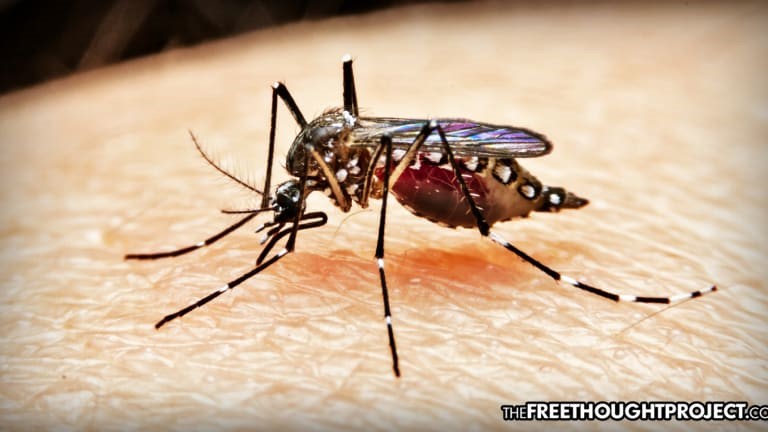
“We use the mosquitoes like they are 1,000 small flying syringes to vaccinate/infect approximately 500-1.000 human beings per mosquito.”
A box full of genetically modified mosquitos successfully vaccinated a human against malaria in a trial funded by the National Institute of Health (NIH).
The study involved about 200 hungry mosquitos biting a human subject’s arm. Human participants placed their arms directly over a small box full of these genetically-modified bloodsuckers.
“We use the mosquitoes like they’re 1,000 small flying syringes,” said researcher Dr. Sean Murphy, as reported by National Public Radio (NPR).
Three to five “vaccinations” took place over 30-day intervals.
The mosquitos gave minor versions of malaria that did not make people sick but gave them antibodies. Efficacy from the antibodies lasted a few months.
“Half of the individuals in each vaccine group did not develop detectable P. falciparum infection, and a subset of these individuals was subjected to a second CHMI 6 months later and remained partially protected. These results support further development of genetically attenuated sporozoites as potential malaria vaccines,” researchers concluded.
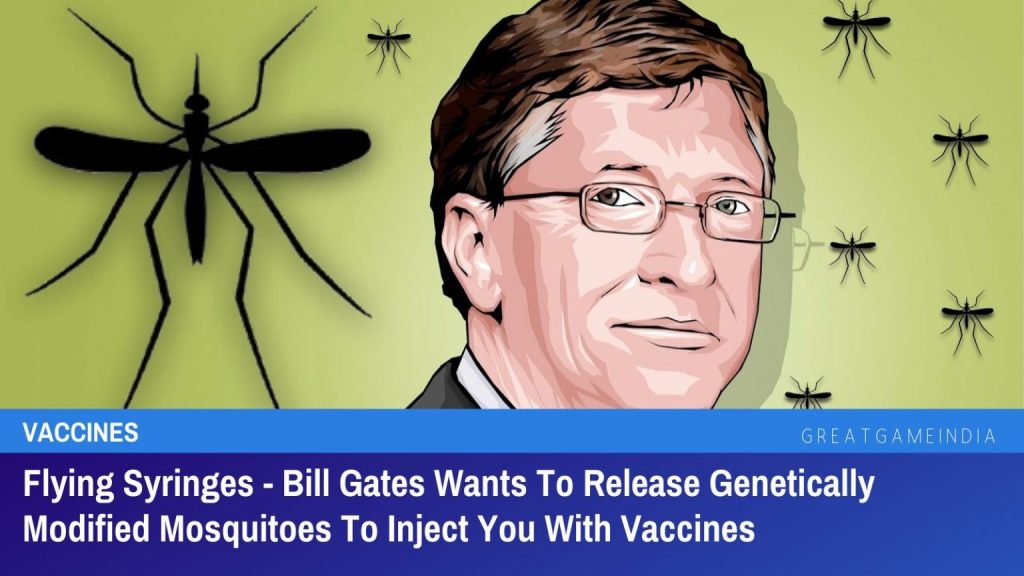
The Bill and Melinda Gates Foundation awarded 1.000.000 dollars each on Wednesday to scientists in 22 countries including funding for a Japanese proposal to turn mosquitoes into “flying syringes” delivering vaccines.
The charitable foundation created by the founder of software giant Microsoft said in a statement that the grants were designed to: “explore bold and largely unproven ways to improve global health.”
The grants were awarded for research into preventing or curing infectious diseases such as HIV/AIDS and tuberculosis and limiting the emergence of drug resistance.
They are the first round of funding for the Gates Foundation’s, “Grand Challenges Explorations,” a five-year 100-million-dollar-per-year initiative to “promote innovative ideas in global health.”
The funding was directed to projects that: “fall outside current scientific paradigms and could lead to significant advances if successful,” the Gates Foundation statement said.
“We were hoping this program would level the playing field so anyone with a transformational idea could more quickly assess its potential for the benefit of global health,” said Tachi Yamada, president of global health at the Gates Foundation. The Gates Foundation said 104 grants were awarded from nearly 4,000 proposals.
The recipients included universities, nonprofit organizations, government agencies, and six private companies. “It was so hard for reviewers to champion just one great idea that we selected almost twice as many projects for funding as we had initially planned,” Yamada said.
Among the proposals receiving funding was one from Hiroyuki Matsuoka at Jichi Medical University in Japan.
“(Matsuoka) thinks it may be possible to turn mosquitoes that normally transmit disease into ‘flying syringes,’ so that when they bite humans they deliver vaccines,” the Gates Foundation said. It said Pattamaporn Kittayapong at Mahidol University in Thailand received a grant to: “explore new approaches for controlling dengue fever by studying bacteria with natural abilities to limit the disease.”
Founded in 1994, the Seattle, Washington-based Bill, and Melinda Gates Foundation is the largest private philanthropic organization in the world.
Dr. Gorter:
When these studies continue and turn out to be successful in „vaccinating,“ why not inject all citizens without their consent against anything Big Pharma and the WHO decided?
Why not vaccinate the world population with mRNA-containing injections and nanotechnology (whatever that might be)?
These mosquitos and other insects they might use in the future are all forms of Gain-of-Function.
Also, Researchers in Japan and the USA alike, have transformed mosquitoes into vaccine-carrying syringes by genetically engineering the insects to express the vaccine for leishmaniasis, a parasitic disease transmitted by the sandfly in their saliva.
According to a study in Insect Molecular Biology, mice bitten by these mosquitoes produced antibodies against the parasite. It is not yet clear whether the immune response was strong enough to protect indefinitely against this infection. But the results are considered to give great hope and opportunities to vaccinate and spread medicines in large populations: even without their consent.
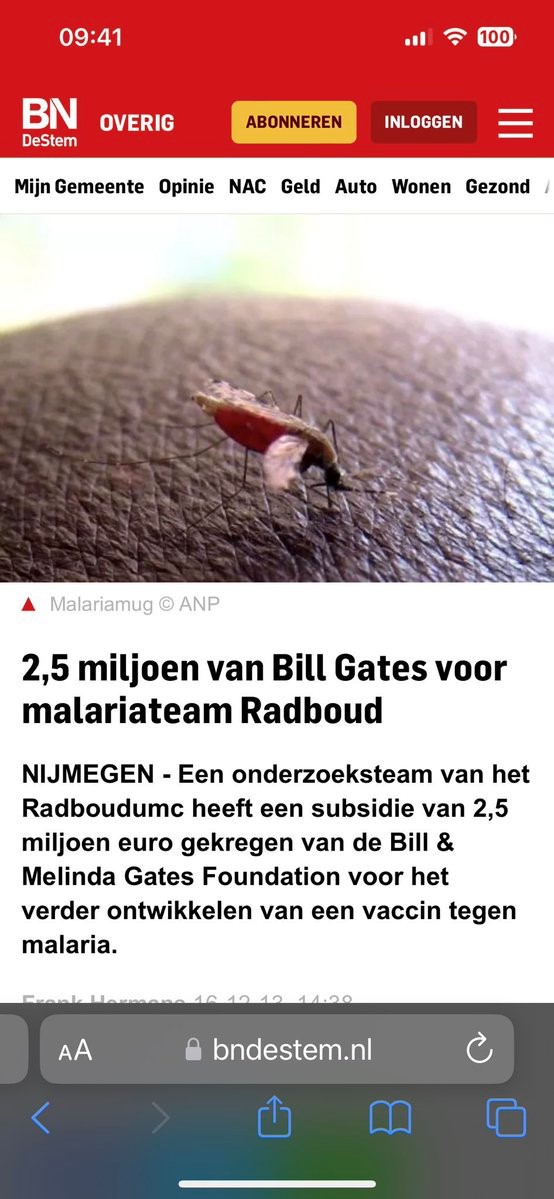
Bill Gates donated 2,5 million € to the University of Nijmegen, The Netherlands, for the further development of a vaccine against malaria AND to further develop genetically altered mosquitos

Marion Koopmans (Erasmus University in Rotterdam, The Netherlands who also works for the WHO for several years and flew several times to the military bio lab in Wuhan, China) admits her team is occupied with developing gene-manipulated mosquitos and other insects (and reptiles) to be prepared for new public health threads like COVID-19 pandemic. Per definition, Marion Koopmans is admitting to being deeply involved in “Gain-of-Function” research.
Mosquitos with Human Genes hinder Malaria Transmission
https://irp.nih.gov/blog/post/2022/08/mosquitos-with-human-gene-hinder-malaria-transmission
Genetically Modified Insects Could Help Curb Infections (Tuesday, August 2, 2022)

PHOTO COURTESY OF DR. JOEL VEGA-RODRIGUEZ
IRP researchers gave mosquitos a human gene, called PAI-1, to reduce the bugs’ ability to transmit malaria. The fluorescent color in their eyes is used as a marker to distinguish the different varieties of genetically modified mosquitoes from one another and from their genetically typical counterparts.
“Scientists create genetically modified mosquitos” sounds like the plot of a bad sci-fi movie, but it’s actually the reality in labs all around the world. Researchers are producing these ‘transgenic’ mosquitos in the hopes that the bugs could help combat the scourge of malaria, and in a recent study, IRP scientists demonstrated that their unique strategy in this realm has strong potential to accomplish that goal.1
According to the US Centers for Disease Control and Prevention (CDC), nearly half of the world’s population lives in areas where malaria is common. The disease, which occurs when an infected mosquito’s bite introduces Plasmodium parasites into a person’s body, caused more than 240 million illnesses and 600,000 deaths in 2020. The disease mostly affects children and pregnant women living in Africa.
While bed nets treated with insecticides and antimalarial drugs have helped to dramatically reduce the number of malaria cases and deaths, this drop has plateaued in recent years as mosquitos have become resistant to the insecticides and the Plasmodium parasite has adapted to shrug off antimalarial medications. Moreover, existing vaccines for the illness only offer protection for a few months at a time, and going back to a clinic for repeated vaccine doses is difficult in the many remote areas of Africa and Asia where malaria is common.
“Malaria has been with us for thousands of years,” says IRP Stadtman Investigator Joel Vega-Rodriguez, Ph.D., the new study’s senior author. “If you go back in history, you can find references to malaria from the ancient Mesopotamian and Greek times. It’s been with us for a long time, and we haven’t been able to control it.”

Dr. Joel Vega-Rodriguez
As the fight against malaria continues, modern scientists are now manipulating mosquito DNA to produce insects that could be introduced in malaria-prone areas to help control the disease’s spread. Some of these bugs have a super-charged immune response to the Plasmodium parasite, while others produce antimalarial molecules in their bodies. Dr. Vega-Rodriguez’s lab, on the other hand, is one of very few — and possibly the only one — that has given mosquitos a human gene to curtail their ability to spread malaria.
Dr. Vega-Rodriguez’s team began pursuing this approach after it discovered that the Plasmodium parasite needs to coat itself with a protein found in the human body, called plasminogen, in order to reproduce inside mosquitos and pass from them to humans.2 When plasminogen is converted into its active form, it degrades a molecule called fibrin that forms blood clots, as well as proteins in the ‘extracellular matrix,’ a molecular mesh that surrounds and protects our cells and tissues. This allows the parasite to move around and reproduce in the mosquito’s gut, which is full of clotted blood, and it also enables the parasite to enter our bodies by tunneling through the extracellular matrix of our skin after an infected mosquito bites us.
“Imagine the parasite as having scissors or a machete and just chopping its way through these extracellular matrix proteins that it has to traverse in order to find a blood vessel,” Dr. Vega Rodriguez explains.
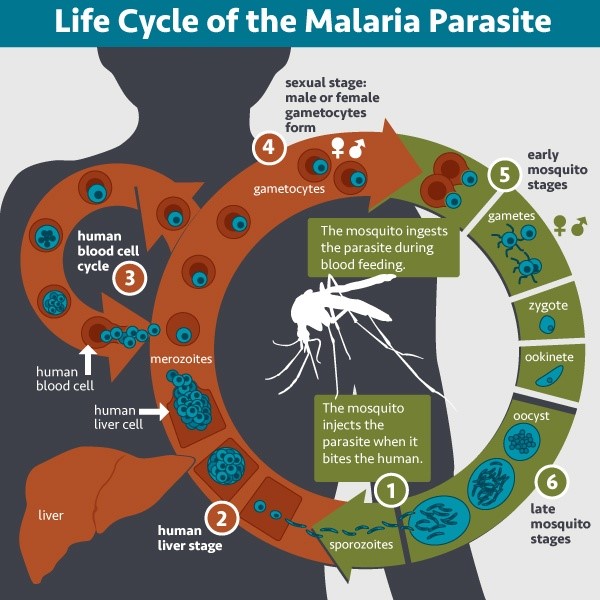
This diagram shows the lifecycle of the Plasmodium parasite that causes malaria.
To create mosquitos that are less likely to spread malaria, his team gave the bugs a human gene called PAI-1, which produces a protein of the same name that prevents plasminogen from being activated. Stopping plasminogen activation, the researchers reasoned, would rob the Plasmodium parasite of the molecular machete it needs to reproduce and spread from mosquitos to humans. Indeed, in their new study, they found that mosquitos that ingested blood containing the parasite and PAI-1 had much less of the parasite’s reproductive form, called an oocyst, in their guts a week later. However, when the active form of plasminogen was added to the blood, the parasite readily multiplied inside the mosquitos.
The IRP team went on to create genetically modified mosquitos that produced PAI-1 in their guts, their salivary glands, or both. The genetic alteration did not reduce the length of the mosquito’s lives or their ability to ingest blood or reproduce, but it did have a dramatic effect on their potential to spread malaria. All three varieties of genetically modified mosquito had significantly fewer oocysts in their guts, and their salivary glands contained much lower numbers of Plasmodium sporozoites, the mobile, infectious form of the parasite that develops inside the oocysts. This reduction was due not only to the smaller number of oocysts in the modified mosquito’s guts, but also because PAI-1 production altered the structure of the mosquitos’ salivary glands in a way that made it more difficult for the sporozoites to infiltrate them.
“We knew that the number of oocysts in the gut was reduced, but there were still plenty of them, and each one produces thousands of sporozoites, so we expected to see good salivary gland invasion,” Dr. Vega-Rodriguez says, “but when we actually looked at the number of sporozoites in the salivary gland, we saw there were very few, which suggests there’s an additional barrier. That makes life for the parasite that much more difficult.”
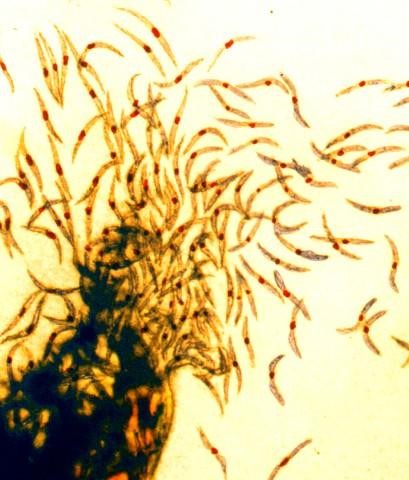
Malaria sporozoites, the infectious form of the malaria parasite that a mosquito’s bite transmits to humans.
Finally, but perhaps most importantly, the modified mosquitos were much less likely to transmit malaria from an infected mouse to a non-infected mouse compared to their genetically normal counterparts. This result, in particular, provides strong evidence that the IRP team’s genetically modified mosquitos are much less likely to spread malaria than their counterparts in the wild.
Of course, genetically modified mosquitos need to be released into areas where malaria is common and largely replace the wild mosquito population there in order to curb the illness’ transmission. This will require not only additional experiments to verify that releasing the mosquitos would be safe, but also continued work on ‘gene drives’ that would help the mosquitos’ genetic alterations spread through local mosquito populations. Once these obstacles are overcome, though, genetically modified mosquitos like the ones created in Dr. Vega-Rodriguez’s lab could one day help save thousands of lives.
“Malaria is an extremely complex disease, and until we get a silver bullet like a vaccine that is highly effective, we have to target this disease from many angles — not only transgenic mosquitos, but also insecticides, drugs, and any other intervention that could prevent the transmission of the disease,” he says. “It could be my transgenics, it could be another group’s, but if we are able to replace the mosquito population with mosquitos that are highly resistant to the parasite, it would certainly have significant impact in reducing the transmission of this deadly disease.”
References:
[1] Pascini TV, Jeong YJ, Huang W, Pala ZR, Sá JM, Wells MB, Kizito C, Sweeney B, Alves E Silva TL, Andrew DJ, Jacobs-Lorena M, Vega-Rodríguez J. Transgenic Anopheles mosquitoes expressing human PAI-1 impair malaria transmission.(external link) Nat Commun. 2022 May 26;13(1):2949. doi 10.1038/s41467-022-30606-y.
[2] Alves E Silva TL, Radtke A, Balaban A, Pascini TV, Pala ZR, Roth A, Alvarenga PH, Jeong YJ, Olivas J, Ghosh AK, Bui H, Pybus BS, Sinnis P, Jacobs-Lorena M, Vega-Rodríguez J. The fibrinolytic system enables the onset of Plasmodium infection in the mosquito vector and the mammalian host. (external link) Sci Adv. 2021 Feb 5;7(6):eabe3362. doi: 10.1126/sciadv.abe3362.
A mosquito AgTRIO mRNA vaccine contributes to immunity against malaria
Abstract
Malaria begins when an infected mosquito injects saliva containing Plasmodium sporozoites into the skin of a vertebrate host. To prevent malaria, vaccination is the most effective strategy and there is an urgent need for new strategies to enhance current pathogen-based vaccines. Active or passive immunization against a mosquito saliva protein, AgTRIO, contributes to protection against Plasmodium infection of mice. In this study, we generated an AgTRIO mRNA-lipid nanoparticle (LNP) and assessed its potential usefulness as a vaccine against malaria. Immunization of mice with an AgTRIO mRNA-LNP generated a robust humoral response, including AgTRIO IgG2a isotype antibodies that have been associated with protection. AgTRIO mRNA-LNP immunized mice exposed to Plasmodium berghei-infected mosquitoes had markedly reduced initial Plasmodium hepatic infection levels and increased survival compared to control mice. In addition, as the humoral response to AgTRIO waned over 6 months, additional mosquito bites boosted the AgTRIO IgG titers, including IgG1 and IgG2a isotypes, which offers a unique advantage compared to pathogen-based vaccines. These data will aid in the generation of future malaria vaccines that may include both pathogen and vector antigens.
In: NPJ Vaccines volume 8, Article number: 88 (2023)

In ancient Roman religion and myth, Janus is the god of beginnings, gates, transitions, time, duality, doorways, passages, frames, and endings. He is usually depicted as having two faces. The month of January is named Janus (Ianuarius).
Prof. Dr. Gorter:
These developments to gene-manipulate insects and reptiles are like the Janus Head with two faces. Also, means “Duality”, “Double Faced”, and “Good and Evil.”
As, these developments in the right hands can have great blessings but in the wrong hands, they can be (and will be) used as “Gain-of-Function.”
This means, that these mosquitos can be used to injure and kill large populations. Also, by using gene manipulation through a patented sequence, that human being becomes the property of the Drug Company or Foundation that holds that patent.